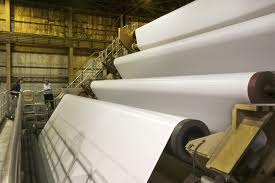
Abitibi Bowater’s Catawba plant was honored Thursday by the state for the company’s efforts to reduce the ozone-producing emissions at its plant – and for its employees’ personal efforts.
The Catawba plant was awarded the “Spare the Air Award.” Last year, the state Department of Health and Environmental Control presented only four such awards throughout the state.
Renee G. Shealy, assistant bureau chief for DHEC’s air quality bureau, said the focus on employees was a primary reason the Catawba plant was honored.
“It’s important to go beyond the plant’s boundaries,” she said. “They gave information to employees that they could take home and make a difference.”
Ozone is formed when nitrogen oxides and volatile organic compounds are “cooked” by the sun. The resulting ground-level ozone is a health hazard causing respiratory problems such as coughing, throat irritations and shortness of breath. It can make asthma worse.
DHEC daily issues an ozone forecast, which is usually more severe in the summer. The local ozone season is from May to September.
Industrial plants and automotives are the biggest sources of ozone-producing emissions. Clean Air Works, a group that includes local governments and businesses, estimates that 55 percent of the ozone in the Charlotte region comes from vehicles.
The U.S. Environmental Protection Agency has determined that the Charlotte region, including York and Union counties in South Carolina, does not meet the standards for low-level ozone pollution.
The nonattainment status means the region needs to work harder to clean its air.
The status has economic complications. Retrofitting plants to curb emissions is costly. The status can also effect economic development efforts, particularly for certain types of manufacturing.
The Catawba plant has been using several conservation measures to reduce the possibility of ozone:
Plant vehicles’ engines are not allowed to be on when not in use.
Compact fluorescent light bulbs have been installed and workers are encouraged to turn off the lights when they leave the room.
More than 500 vehicle gas caps were tested. Fifteen did not fit well, allowing gasoline vapors to leak into the air. They were replaced.
Other normal plant operations, such as cutting electric consumption by 50 to 100 megawatts during the afternoon, help the Catawba plant not only save on power costs, but reduce the emissions that lead to ozone.
The changes have helped the plant reduce its energy needs by 10 percent and its nitrogen oxide emissions by 20,000 pounds per month, according to DHEC.
The plant’s emissions are regulated and monitored by DHEC. The smoke that swirls around the plant during operations, however, is largely steam, said plant manager Mike Forrest.
The plant has also asked workers to do their part at home and on the way to work. Workers have been asked to carpool, and those who do get the parking spaces closest to the front door. Workers who drive are encouraged to fill their gas tanks in the evening hours when the gasoline vapors can’t be “cooked” into ozone.
The company has also had several education events on electric vehicles, mass transportation and electric lawn equipment to help workers understand how they can make a difference.
By Don Worthington, Staff Reporter with The Herald

 (803) 327-9041
(803) 327-9041
